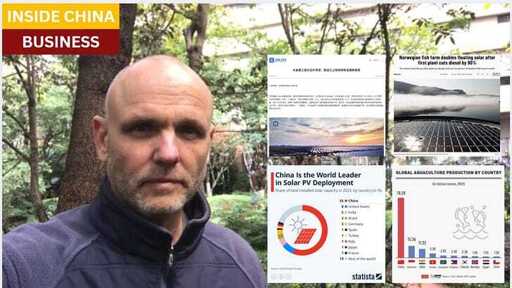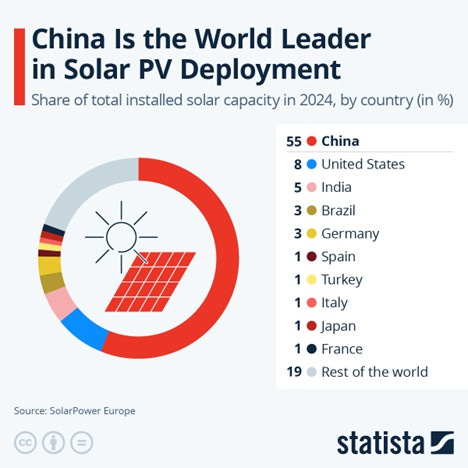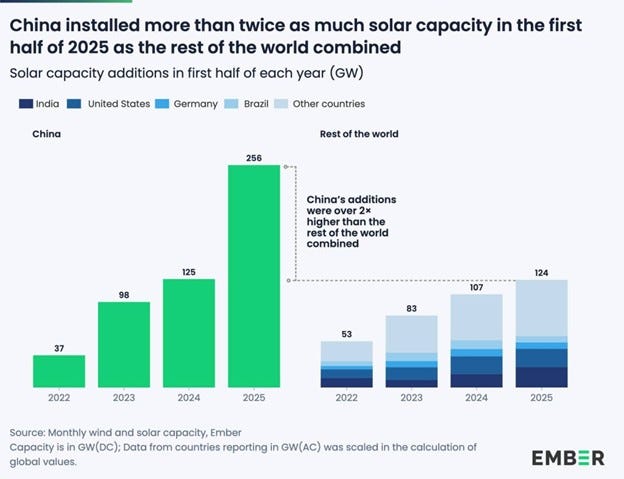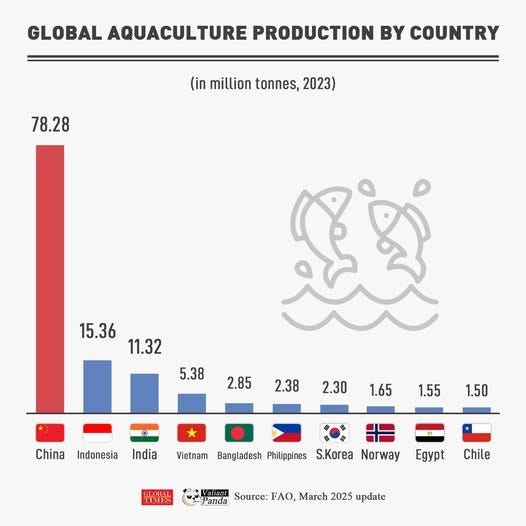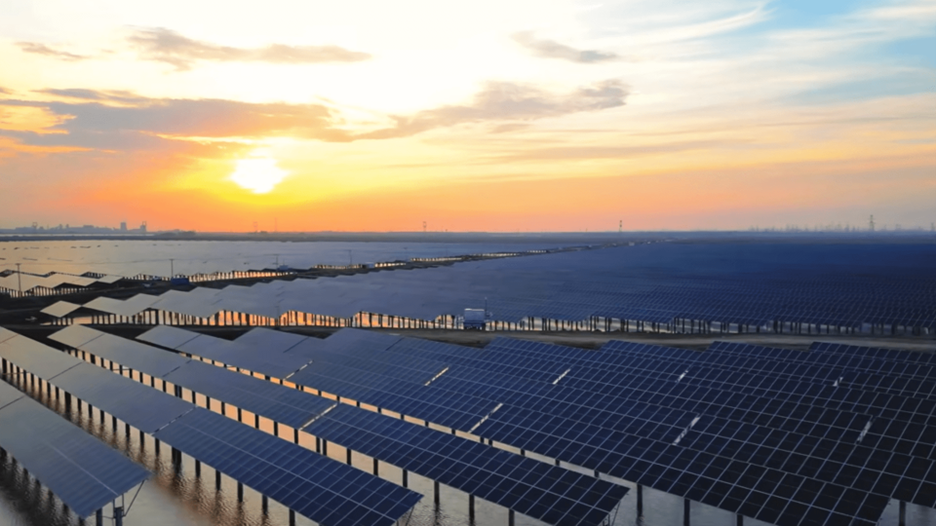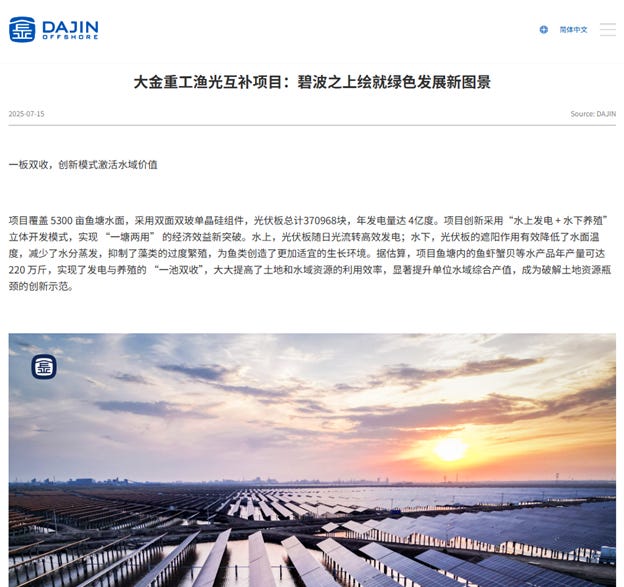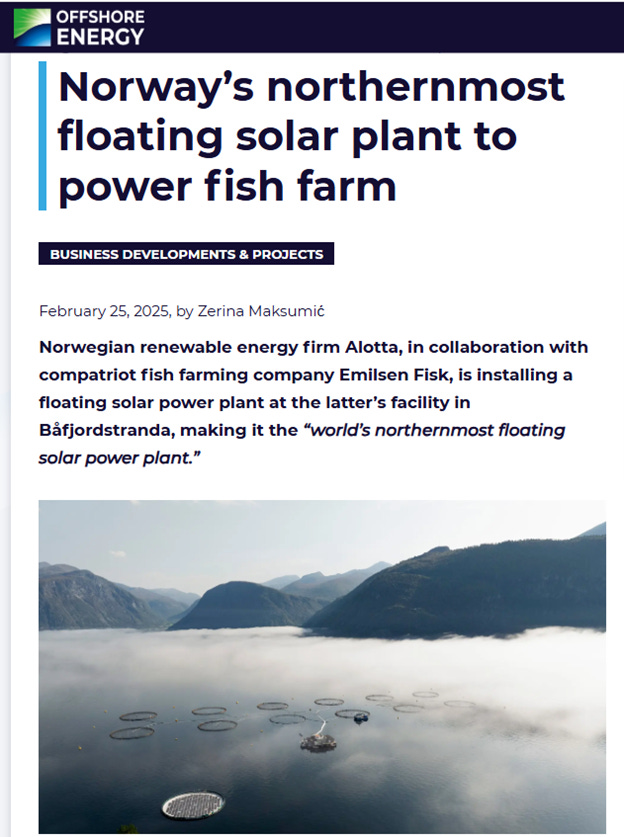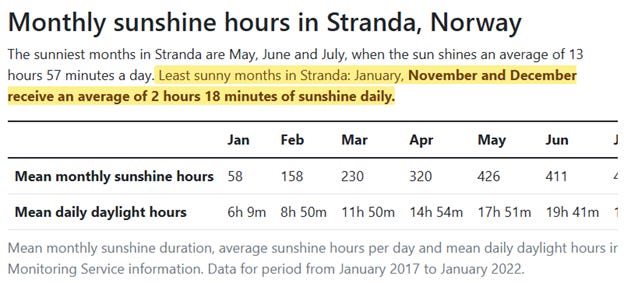Bullets:
Chinese engineers developed a transformative approach to fish farming, by installing bifacial solar panels above the ponds.The hybrid farm now produces clean power for 40,000 homes, with substantial improvements in aquacultural yields.Engineers in Norway applied some of the same techniques to build the world’s Northernmost fish farm. Even though the area receives little sunlight for much of the year, the solar setup displaced 90% of the farm’s diesel fuel needs.
Inside China / Business is a reader-supported publication. To receive new posts and support my work, consider becoming a free or paid subscriber.
The YouTube video for this report may be found here:
Report:
Good morning.
China is the world’s leader in solar panel production and installation. In 2024, China installed more solar capacity than the rest of the world, combined:
And in the first half of 2025, Chinese firms installed over twice as much solar capacity, than the rest of the world, combined:
China is also the world’s leader in farmed fish. And here again in this industry, Chinese fish farms are easily more than the rest of the world, combined:
China mass produces so much fish of all kinds, that the Chinese aquaculture industry is blowing up markets in Europe for caviar, and for the species that are threatened and are heavily regulated to limit fishing there so that stocks can recover.
So Chinese companies don’t have a lot to learn from anyone else about solar farms, or fish farms. And it was only a matter of time before the guys doing the first thing bumped into the people doing the second thing and started asking a bunch of “what-if’s?”
Fast-forwarding a bit, and Chinese engineers are combining solar farms with fish farms, and now are dramatically improving yields of both.
These are bifacial solar panels—with solar cells on both sides of the panel, and they put 370,000 of them on a fish farm. This is the announcement from the company, Dajin Offshore, for the new hybrid fish-solar farm in Tangshan, Hebei:
Operators for Dajin estimate that the annual production of fish and shellfish is 2.2 million jin. A jin is half a kilo, about 1.1 pounds, so the farm will produce over one thousand tons—metric or imperial—of fish, shrimp, and crab.
The solar panels are installed over large areas for the fish, and capture sunlight on both sides of the panel. Sunlight reflects off the water, and is collected on the reverse side. The solar farm generates 400 million kilowatt hours of electricity per year, which is enough to power about 40,000 homes.
The solar farm is also more efficient than land-based farms, up to 15% more efficient, because water is a cooler surface. The system is also beneficial for the fish operations, because the solar panels are cooling the water from the top down. Fish metabolism is improved, disease is reduced, and there is a reduction in evaporation.
Three years ago a 70-MW farm went into Cangzhou, and the concept was proven then. This project in Tanghsan is the most recent, and the largest so far, in Hebei province.
And now the idea is going global, and engineers in Norway are successfully doing the same thing there, almost. Many fish farms there are powered with diesel generators, and the idea was to have power from solar generation displace the need for diesel. The facility is in Bafjordstanda, and it’s the world’s northernmost.
The solar panels on the farm in Norway are not bifacial, as they are in Hebei—these here are floating on the surface of the water, so they’re only generating power from just one direction. But the system worked more successfully than engineers hoped. Diesel fuel demand dropped by 90 percent, and power from the solar is almost enough to power the entire farm. It is almost entirely self-sufficient, and that makes the whole concept very compelling for other aquaculture projects that are distant from grid power.
What’s more, the success of the Norway project was surprising, because of where Norway is. Above are the climate data for Stranda. On average each year, they see one day above 25 degrees, and 159 days below zero.
In the winter months, the sun shines under three hours a day. So if you like very cold weather, and darkness—and fish—this might be the place for you. Anyway, the engineers there found that even in the wintertime, in low light conditions, the solar system provided sufficient power. So the company announced the construction of another one.
Chinese aquaculture and Chinese solar are first in class. And just because people here lumped them together and it worked out really well in China, it doesn’t mean at all it will work anywhere else. But we might be able to say that if that thing works even in Norway, even in winter, it will probably work everywhere else.
Be good.
Resources and links:Dajin commissions 250 MW fishery-solar hybrid in chinahttps://www.offshore-energy.biz/dajin-commissions-250-mw-fishery-solar-hybrid-in-china/China is mass producing endangered fish and wrecking European caviar markets
Norwegian fish farm doubles floating solar after first plant cuts diesel by 90%https://interestingengineering.com/innovation/norwegian-second-floating-solar-plant370,000 solar panels grace one of world’s largest hybrid fishery farms in chinahttps://interestingengineering.com/energy/massive-solar-farm-with-370000-solar-panelsAlotta implements a floating solar plant to make aquaculture more sustainablehttps://inspenet.com/en/noticias/alotta-implements-a-floating-solar-plant-to-make-aquaculture-more-sustainable/H1 2025: China installs more solar than rest of the world combinedhttps://electrek.co/2025/09/02/h1-2025-china-installs-more-solar-than-rest-of-the-world-combined/Norway%E2%80%99s northernmost floating solar plant to power fish farmhttps://www.offshore-energy.biz/norways-northernmost-floating-solar-plant-to-power-fish-farm/
Inside China / Business is a reader-supported publication. To receive new posts and support my work, consider becoming a free or paid subscriber.
From Inside China / Business via this RSS feed


